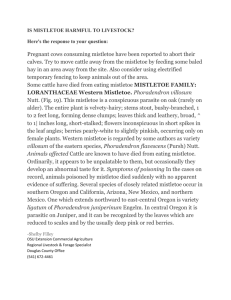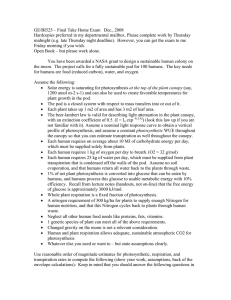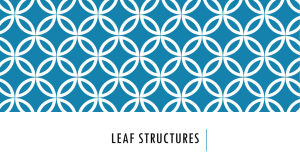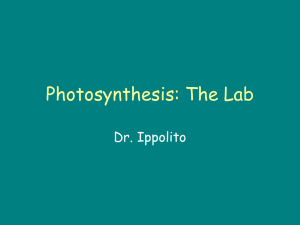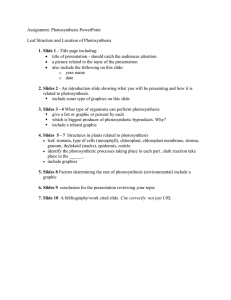Phoradendron villosum, Quercus lobata Photosynthesis and water relations of the mistletoe,
advertisement
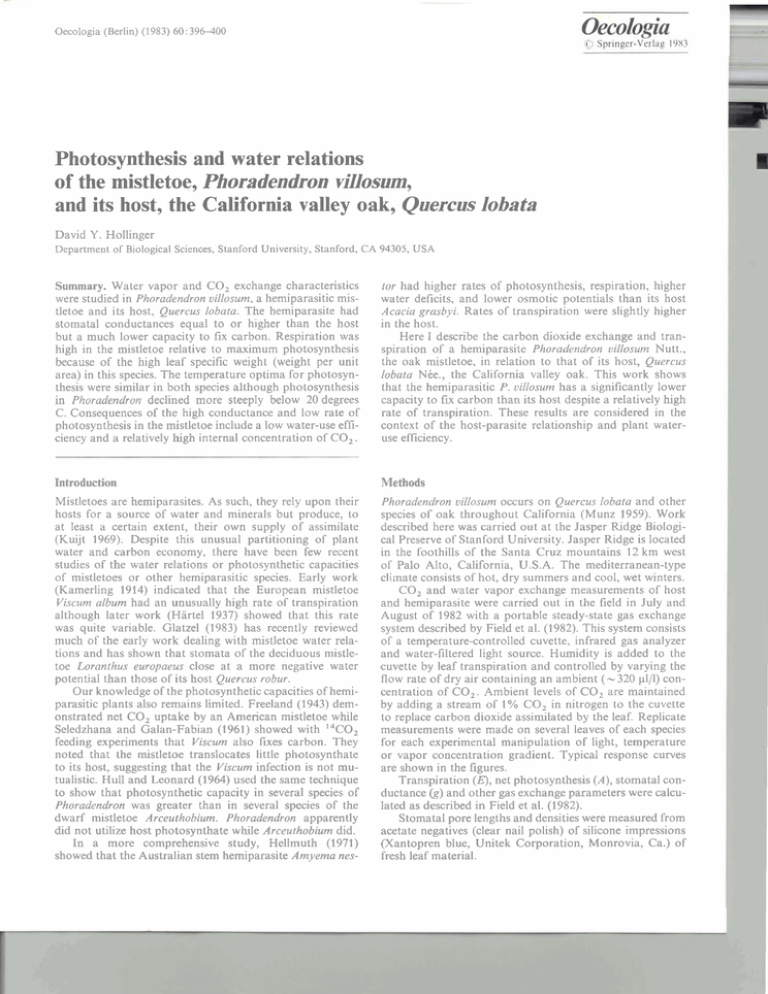
Oecologia (Berlin) (1983) 60 :396-400 Photosynthesis and water relations of the mistletoe, Phoradendron villosum, and its host, the California valley oak, Quercus lobata David Y. Hollinger Department of Biological Sciences, Stanford University, Stanford, CA 94305, USA Summary. Water vapor and CO, exchange characteristics were studied in Phoradendron villosum, a hemiparasitic mistletoe and its host, Quercus lobata. The hemiparasite had stomatal conductances equal to or higher than the host but a much lower capacity to fix carbon. Respiration was high in the mistletoe relative to maximum photosynthesis because of the high leaf specific weight (weight per unit area) in this species. The temperature optima for photosynthesis were similar in both species although photosynthesis in Phoradendron declined more steeply below 20 degrees C. Consequences of the high conductance and low rate of photosynthesis in the mistletoe include a low water-use efficiency and a relatively high internal concentration of CO,. tor had higher rates of photosynthesis, respiration, higher water deficits, and lower osmotic potentials than its host Acacia grasbyi. Rates of transpiration were slightly higher in the host. Here I describe the carbon dioxide exchange and transpiration of a hemiparasite Phoradendron uillosum Nutt., the oak mistletoe, in relation to that of its host, Quercus lobata N6e., the California valley oak. This work shows that the hemiparasitic P. villosum has a significantly lower capacity to fix carbon than its host despite a relatively high rate of transpiration. These results are considered in the context of the host-parasite relationship and plant wateruse efficiency. Introduction Methods Mistletoes are hemiparasites. As such, they rely upon their hosts for a source of water and minerals but produce, to at least a certain extent, their own supply of assimilate (Kuijt 1969). Despite this unusual partitioning of plant water and carbon economy, there have been few recent studies of the water relations or photosynthetic capacities of mistletoes or other hemiparasitic species. Early work (Kamerling 1914) indicated that the European mistletoe Viscum album had an unusually high rate of transpiration although later work (Hartel 1937) showed that this rate was quite variable. Glatzel (1983) has recently reviewed much of the early work dealing with mistletoe water relations and has shown that stomata of the deciduous mistletoe Loranthus europaeus close at a more negative water potential than those of its host Quercus robur. Our knowledge of the photosynthetic capacities of hemiparasitic plants also remains limited. Freeland (1943) demonstrated net CO, uptake by an American mistletoe while Seledzhana and Galan-Fabian (1961) showed with I4CO2 feeding experiments that Viscum also fixes carbon. They noted that the mistletoe translocates little photosynthate to its host, suggesting that the Viscum infection is not mutualistic. Hull and Leonard (1964) used the same technique to show that photosynthetic capacity in several species of Phoradendron was greater than in several species of the dwarf mistletoe Arceuthobium. Phoradendron apparently did not utilize host photosynthate wtule Arceuthobium did. In a more comprehensive study, Hellmuth (1971) showed that the Australian stem hemiparasite Amyema nes- Phoradendron villosum occurs on Quercus lobata and other species of oak throughout California (Munz 1959). Work described here was carried out at the Jasper Ridge Biological Preserve of Stanford University. Jasper Ridge is located in the foothills of the Santa Cruz mountains 12 km west of Palo Alto, California, U.S.A. The mediterranean-type cliinate consists of hot, dry summers and cool, wet winters. CO, and water vapor exchange measurements of host and hemiparasite were carried out in the field in July and August of 1982 with a portable steady-state gas exchange system described by Field et al. (1982). This system consists of a temperature-controlled cuvette, infrared gas analyzer and water-filtered light source. Humidity is added to the cuvette by leaf transpiration and controlled by varying the flow rate of dry air containing an ambient (- 320 ~111)concentration of CO,. Ambient levels of CO, are maintained by adding a stream of 1% CO, in nitrogen to the cuvette to replace carbon dioxide assimilated by the leaf. Replicate meaiurements were made on several leaves of each species for each experimental manipulation of light, temperature or vapor concentration gradient. Typical response curves are shown in the figures. Transpiration (E), net photosynthesis ( A ) , stomatal conductance (g)and other gas exchange parameters were calculated as described in Field et al. (1982). , , Stomata1 pore lengths and densities were measured from acetate negatives (clear nail polish) of silicone impressions (Xantopren blue, Unitek Corporation, Monrovia, Ca.) of fresh leaf material. Quercus B 0 I 2 Photosynthetically act~vephoton flux 3 - 5 6-10 11-20 2 2 0 Mistletoe plants per oak Fig. 1. Distribution of Phoradendron on 50 Quercus lobata individuals ( p rnol rri25') Fig. 2. Leaf photosynthesis and conductance of Phoradendron and Quervus as a function of photosynthetically active photon flux. ' A W = 10 mmol H,O mol- air, leaf temperature = 25 degrees C Results and discussion Table I. Photosynthetic characteristics of Phoradendron and QuerCUS Frequency of infection Parasitism of Q. lobata and other species by Phoradendron is common at Jasper Ridge. Although I report only on Phoradendron utilizing Q. lobata as a host, its occurrence was noted o n Q. douglassi, Q . agrifolia and Q . durata as well. Fifty Q. lobata trees at Jasper Ridge were surveyed for the presence of P. viilosum infections in February of 1982 by running transects through the oak savanna until the requisite number of individuals were encountered. The evergreen Phoradendron is easily visible among the bare branches of its deciduous host a t this time of year. Just under one-half of the Q. lobata trees surveyed contained at least one Phoradendron plant, while 16% of the oaks were host to 6 or more mistletoe plants (Fig. 1). The occurrence of Phoradendron on the Quercus hosts was not random (Poisson), P<0.05, Koimogorov-Smirnov test. Instead, the distribution of Phoradendron was clumped, with two of the Quercus plants host to 49% of all the mistletoe plants encountered. These hosts were not otherwise distinctive in size or habitat, suggesting that dispersal or host susceptibility factors are important in mistletoe distribution. Gas exchange measurements Photosynthetic and transpiration rates of the host plant and hemiparasite were determined as functions of light, leaf temperature and vapor concentration gradient ( A W). Each of these responses is discussed in turn. CO, exchange and stomata1 conductance of Q. lobata and Phoradendron on a unit area basis are shown as a function of photosynthetically active photon flux in Figs. 2 A and B. The relatively high light intensity required for saturation Phoradendron Maximum Ratea (pmol m-' s- ') Dark Respiration (pmol m-' s-' at 25 C) Photosynthetically active photon flux for one-half maximum rate (pmol m-' s-') 8.46f 1.30 leaves 8.4 stem -1.84k0.19 Quercus 16.76k 1.73 -1.05*0.10 (Values* one std. dev., n =8 for maximum rate and dark respiration figures, n=3 for one-half maximum rate photon flux.) " PAPF=1,500 pmol m-'s-', A W=lO mmol H,O mol-' air, leaf temperature= 25 degrees C and high rate of net CO, uptake observed in Quercus (Table 1 ) are typical of leaves adapted to sunny conditions, while the much lower maximum rate and lower light intensity necessary for saturation of the photosynthetic apparatus in Phoradendron are more typical of species adapted to shade (Bjorkman 1981). The leaves in Phoradendron, however, unlike those in most shade plants have a high tissue weight per unit area (Table 2). The leaf specific weight (weight per unit area) of mistletoe is almost 3 times that of Q . lobata. This means that the photosynthetic rate of Phoradendron on a weight basis is extremely low (only 115 that of its Quercus host). This very high leaf specific weight also accounts for the relatively high rate of dark respiration of Phoradendron (Fig. 2 A ) on a unit area basis. A consequence of the high leaf specific weight and low maximum rate of photosynthesis is that the daily leaf carbon balance per unit area is considerably lower in the mistletoe than in its host. The green stems of Phoradendron are capable of net photosynthesis (Table I), partially compensating for the less favorable carbon balance of the leaves. Table 2. Leaf characteristics of Phoradendron and Quercus Phoradendron Leaf Size (cm2) n=18 Specific wt. (g1n-~)n=18 4.03 Quercus 25.48 & 10.29 1.52 Phoradendron August 26 411 k 6 4 144k 12 Stornatal Deosity (stoma rnrn-,)' 58.4k 14.5 (leaf) 6.4k4.2 (stem) Stornatal Pore Length (pm) n = 360 28.8 t3.1 /. 389 f46 14.2k2.3 B . Quercus -.-.-.-- (All valueskone std, dev.) " Measured at 6 locations on 12 leaves Fig dro tive July 28 Auercus July 27 Phoradendron 1982 - 0 10 15 25 X) Leaf temperature 30 35 40 U (OC) Fig. 3. Normalized net photosynthesis as a function of temperature in Phoradendron and Quercus. PAPF = 1,000 pmol m-' sA W = 5 mmol H 2 0 mol- air ' ', Despite the large differences in net CO, uptake between host and hemiparasite, stomatal conductances in both species are similar (Fig. 2 B). Stomata are larger but less numerous in Phoradendron than Quercus (Table 2). Stomatal conductances are discussed in more detail below with reference to the water use efficiency of both species. Temperature The responses of net photosynthesis in Phoradendron and Quercus to temperature are qualitatively similar (Fig. 3). The optimum range of temperatures for maximum photosynthesis is apparently somewhat broader in the oak than in the mistletoe, however. Greater than 90% of the maximum rate of photosynthesis is observed in the oak with leaf temperatures ranging from 15 degrees C (the lowest leaf temperature measured) to approximately 32 degrees C. The temperature response of the mistletoe was similar although it appeared to drop off steeply below about 20 degrees C. Wagener (1957) has noted the sensitivity of Phoradendron to low temperatures. Vapor concentration gradient In contrast to Quercus, net CO, uptake in Phoradendron declines only slightly with an increasing leaf-air vapor concentration gradient (Fig. 4A). This is not because Phoradendron stomata fail to respond to an increasing AW, but because of the high conductance of this species relative to its photosynthetic capacity (Fig. 4C). At a light intensity of 1,000 ~mol/m2s,the stomatal conductance of Phoradendron is approximately 2 and one-half times that of its host 0 4 8 12 16 20 24 28 32 Vapor concentration gradient (mmol H20 / mol air) Fig. 4A-D. Net photosynthesis, transpiration, stornatal conductance to water vapor and ratio of intercellular CO, to external CO, as functions of leaf-air vapor concentration gradient. PAPF= 1,000 pmol m-' s - l , leaf temperature=30 degrees C while the net rate of CO, uptake in the mistletoe is only one-half that of the oak. Because of the high conductance and low photosynthetic rate, even at a AW of greater than 30 mmol H,O/mol air, the internal concentration of CO, in Phoradendron is over 90% of that existing outside of the leaf. This contrasts sharply with the internal concentrations of CO, in Quercus (Fig. 4 D). The very high rate of transpiration combined with the low rate of net photosynthesis in Phoradendron means that E/A, the instantaneous water-use efficiency, of this species is very low. As Figs. 5A and B show, compared to its host, Phoradendron is indeed a profligate user of water. At a light intensity of 1,000 pmol/m2s and depending on the vapor concentration gradient, Phoradendron transpires from 3 to 5 times as much water as its host at the same AW per equivalent unit of photosynthesis. Figure 5 b shows instantaneous water use efficiency (EIA) for the two species as ligth varies but at a constant A Wof 8.5 1 mmol H,O/mol air. There is a large difference in water use efficiency (mols water transpired per mol carbon assimilated) even at the low light intensities which Phoradendron often experiences. Cowan and Farquhar (1977) have suggested that the slope of the relationship between E and A (dE/dA) provides another test of the efficiency of water use in a plant. In their model, given a certain amount of water to be transpired throughout a day, carbon gain is maximized (water-use efficiency is optimized) if dE/dA is constant. dE/dA in Phoradendron and Quercus was evaluated by the method of Far- +
